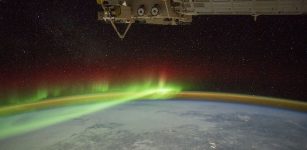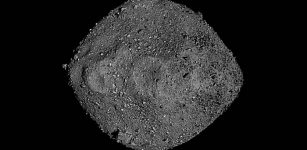Multiple Former Ice Caps Buried Under Mars’ North Pole
Eddie Gonzales Jr. – MessageToEagle.com – Researchers at the University of Texas at Austin and the University of Arizona have discovered remnants of ancient ice sheets buried in sand a mile beneath Mars’s North Pole.
The findings show conclusive evidence of the waxing and waning of polar ice on the red planet due to changes in its orbit and tilt. The Martian layers of ice are a record of past climate on Mars in much the same way that tree rings are a record of past climate on Earth, researchers say
A vertically exaggerated view of Mars’ north polar cap. Researchers estimate that if melted, the
massive ice deposits discovered in this region would cover the planet in 1.5 meters (5 feet) of water.
Credit: SA/DLR/FU Berlin; NASA MGS MOLA Science Team.
The team found layers of sand and ice that were as much as 90 percent water in some places. If melted, the newly discovered ice would be equivalent to a global layer of water around Mars at least 1.5 meters (5 feet) deep, which could be one of the largest water reservoirs on the planet, according to the researchers.
“We didn’t expect to find this much water ice here,” Stefano Nerozzi, a graduate research assistant at the University of Texas Institute for Geophysics (UTIG) and lead author of the new study, said in a press release.
“That likely makes it the third largest water reservoir on Mars after the polar ice caps.”
The authors suspect the layers formed when ice accumulated at the poles during past ice ages on Mars. Each time the planet warmed, a remnant of the ice caps became covered by sand, which protected the ice from solar radiation and prevented it from dissipating into the atmosphere.
A composite image showing alternating layers of ice and sand in an area where they are exposed on the surface of Mars. The photograph, taken with the HiRISE camera aboard NASA’s Mars Reconnaissance Orbiter, was adjusted to show water ice as light-colored layers and sand as darker layers of blue. The tiny bright white flecks are thin patches of frost. Credit: NASA/JPL/University of Arizona.
Scientists have long known about glacial events on Mars, which are driven by variations in the planet’s orbit and tilt. Over periods of about 50,000 years, Mars leans toward the sun before gradually returning to an upright position, like a wobbling spinning top.
When the planet spins upright, the equator faces the sun, allowing the polar ice caps to grow. As the planet tilts, the ice caps retreat, perhaps vanishing entirely. The new findings show that in fact significant ice sheet remnants have survived under the planet’s surface, trapped in alternating bands of ice and sand, like layers on a cake, and the ancient ice caps of Mars were never lost.
“Surprisingly, the total volume of water locked up in these buried polar deposits is roughly the same as all the water ice known to exist in glaciers and buried ice layers at lower latitudes on Mars, and they are approximately the same age,” Nerozzi said.
“Understanding how much water was available globally versus what’s trapped in the poles is important if you’re going to have liquid water on Mars,” he said.
“You can have all the right conditions for life, but if most of the water is locked up at the poles, then it becomes difficult to have sufficient amounts of liquid water near the equator.”
Written by Eddie Gonzales Jr. – MessageToEagle.com Staff Writer












